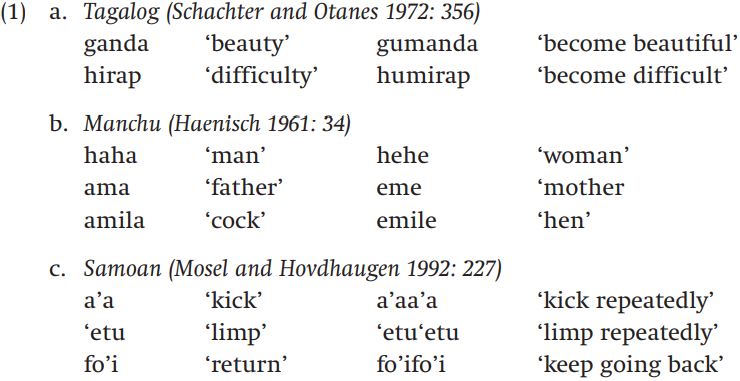


 Grammar
Grammar
 Tenses
Tenses
 Present
Present
 Past
Past
 Future
Future
 Parts Of Speech
Parts Of Speech
 Nouns
Nouns
 Verbs
Verbs
 Adverbs
Adverbs
 Adjectives
Adjectives
 Pronouns
Pronouns
 Pre Position
Pre Position
 Preposition by function
Preposition by function 
 Preposition by construction
Preposition by construction
 Conjunctions
Conjunctions
 Interjections
Interjections
 Grammar Rules
Grammar Rules
 Linguistics
Linguistics
 Semantics
Semantics
 Pragmatics
Pragmatics
 Reading Comprehension
Reading Comprehension|
Read More
Date: 2023-09-21
Date: 2024-02-06
Date: 2023-10-12
|
Lexeme formation: further afield
Introduction

These examples should look quite different from the kinds of morphology that we’ve concentrated on so far: prefixation, suffixation, compounding, and conversion. In (1a), it looks like a morpheme has been inserted right into a base to form a verb. In (1b), vowels have changed to form the female correlates of male nouns, and in (1c), segments of the base are repeated to form what’s called the frequentative form of the verb (for a verb meaning X, this form means ‘X repeatedly’). Prefixation, suffixation, compounding, and conversion may be the main ways of forming new words in English and many other languages, but there’s a much wider world out there, and there are types of morphology that do not figure in English at all, or figure only in the most minor ways.
we’ll expand our horizons by surveying a number of morphological processes that we have not yet encountered: different kinds of affixes, internal stem changes to consonants and vowels, reduplication, and templatic morphology. Our concentration will be on the structural aspects of morphology – the kinds of rules that languages can make use of to form new words – as opposed to the semantic or grammatical aspects. Our aim here is to characterize a sort of universal toolbag of rules which languages may make use of in word formation.
|
|
|
|
دخلت غرفة فنسيت ماذا تريد من داخلها.. خبير يفسر الحالة
|
|
|
|
|
|
|
ثورة طبية.. ابتكار أصغر جهاز لتنظيم ضربات القلب في العالم
|
|
|
|
|
|
|
بالصور: ممثل المرجعية العليا الشيخ عبد المهدي الكربلائي يؤم جموع المؤمنين في صلاة عيد الفطر المبارك داخل الصحن الحسيني الشريف
|
|
|